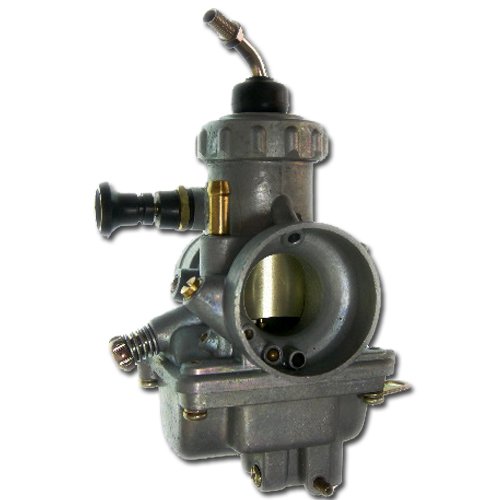Let’s get something straight right away. If someone is giving you one-size-fits-all carburetor jetting specs, it is best to use them as merely a baseline and not as gospel.
Unless they are riding the exact same type of bike on the exact same day in the exact same conditions with the exact same riding style, only a fraction of their advice will do you any good.
There are an enormous amount of factors that go into carb jetting—air temperature, altitude and the composition of the fuel additives sold at various elevations, riding style, and more.
We are nevertheless going to share some of the basics of carb jetting to help you maximize power and extend the life of your four-stroke dirt bike engine.
A carburetor is designed to mix fuel and air at a precise ratio and deliver it to your engine. But there are constantly changing forces affecting that ratio, and to get the very best engine performance possible, you’re going to have to monitor whether your bike is running too rich or too lean, and adjust your jets accordingly.
[important]Tech tip: Jet wrenches are an inexpensive way to make adjusting your jetting a little faster and easier.[/important]
The Top Carb-Jetting Influencers
Weather
Temperature can play a huge role in how your dirt bike engine runs. As the air temperature rises, the air density becomes lower, causing a richer mixture. To combat the rich condition, you will have to use jet sizes with lower numbers to compensate for lower air density. If barometric pressure decreases, the opposite effect will occur, and you will have to adjust for higher air density with higher jet sizes.
In addition to temperature, humidity can affect engine performance. As humidity increases, your engine takes in less oxygen and more water, and will likely cause your bike to run rich. Swapping in smaller jets is the proper response.
Altitude
Typically, air density decreases at higher altitudes. When riding on race tracks or trails in high altitudes, smaller jets and increasing your engine’s compression ratio will compensate for the lower air density. Gas stations sell fuel formulated for the specific region it’s sold in relative to altitude. Fuel purchased at sea level will affect your bike’s performance if ridden in, say, Moab, UT, where the elevation is higher than 4,000 feet. For optimum performance, you would need to adjust your jetting to compensate for the sea level-formulated fuel. And if you refueled with gas bought at high elevations? You’d have to adjust your jetting again to play nicely with the new fuel.
Track and Trail Conditions
Ground conditions have an enormous influence on jetting because of the varying load put on your engine by mud, sand, large hills, and other obstacles. More obstacles require more fuel, and generally, richer jetting.
Consider motocross track conditions as an example.
In the morning, the air temperature is typically cooler and the ground is typically wetter, making richer jetting optimum for peak engine performance. And in the afternoon, as the air temperature rises and the ground dries, adjustments to leaner jetting is required to get the most out of your bike’s performance.
Diagnosing Rich vs. Lean Conditions
Your engine runs rich when your carb is delivering too much gas. Here are common symptoms:
- Sluggish acceleration
- Uneven running and idle
- Soot on spark plugs
- Soot on muffler ends
Your engine runs lean when your carb is delivering too much air. Here are common symptoms:
- Uneven lurching while accelerating
- White spark plugs
- Engine requires unusual amount of choke to start
- Backfiring as the throttle closes
The Main Metering Points and Throttle Positions
Carb jetting is affected at different throttle positions.
For air:
The air screw – closed to 1/8 throttle
The throttle slide – 1/8 to 1/2 throttle
The air jets – 1/2 to full-open throttle
For fuel:
The pilot/slow jet – Closed to 1/4 throttle
The spray bar – 1/2 to full-open throttle
The jet needle – 1/4 to 1/2 throttle
The main jet –1/2 to full-open throttle


[…] Re-jet your carburetor (if necessary) This one’s certainly easier said (or written) than done, because of all the varying factors that can affect your engine’s performance. Altitude, for example, can greatly affect both air/fuel ratios and gasoline performance, as gas sold at sea level has a different additive mix than gas stored and sold at high elevations, and less air density requires less gas usage for the perfect mix. Read An introduction to Carburetor Jetting for Four-Stroke Dirt Bikes here. […]
[…] https://www.onallcylinders.com/2013/03/21/an-introduction-to-carburetor-jetting-for-four-stroke-dirt-… […]